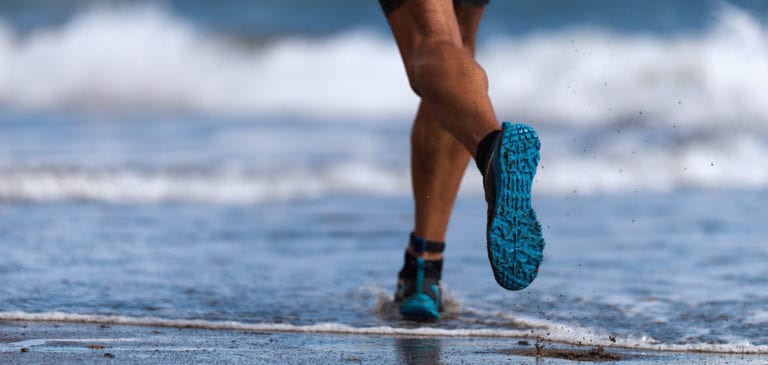Whether you’re a seasoned runner looking to spice up your running routine or a trail runner who is coming back from injury or searching for a structured trail running training plan, hitting the trails can yield multiple benefits for regular recreational runners. From giving your body a rest from pounding the roads all week to getting you outside in the fresh air and offering you a whole-body workout, trail running is great for fitness, endurance, and overall fun outdoors. However, how can you train appropriately for trail running so you make the most of your days out?
Trail running presents several new challenges for running training, from uneven terrain to steep climbs and descents you won’t find in a city. Moreover, it requires additional skills to running, like navigation, and particular attention to the kit you use. Here’s how to start your trail running training to optimize your days out as a beginner runner or if you’re transitioning from road to trail.
Trail Running vs. Road Running: Key Differences
Beyond the obvious difference in terrain, trail running is different from running on roads on various accounts:- Trail running engages more muscles than road running. While your whole body will play a role in running in general, when you switch to trails you will need to work on your balance and core strength. This is because of the variety in terrain, but also due to the technical nature of trails.
- Trail running is more technical. You will encounter technical terrain, i.e. not smooth like a sidewalk. This means you need to develop skills to deal with anything from mud and slippery surfaces, to rough terrain like rocks, tree roots etc.
- You will go further – most likely. If you’ve looked up trail runners, you’ll have probably noticed that they tend to be ultra-runners. Professional athletes like Courtney Dauwalter, who wins 200-mile trail races outright, run longer distances than typical road running athletes. This will influence how many runs per week you do and the type of trail running training you’ll engage in if you want to race the typical longer ultra distances.
- You will need different – and more – kit. The first big difference between roads and trails is, of course, shoe choice. You will need to look into shoes designed to deal with rougher terrain, different weather, and longer distances. Beyond shoes, however, you also need to consider clothing that will protect you from the elements, such as waterproof jackets and whatever race directors throw into your mandatory kit list. If you run into the night, for example, you’ll need a headlamp.
- There’s a fine line between trail and mountain running. Once you become more comfortable with technical running and develop more of an interest in outdoor adventures, you may find you become keen to tackle mountain running. This is where you’ll begin to need orienteering and navigation skills, as well as better endurance and awareness of how to stay safe on trails.
What Muscles Do You Need For Trail Running?
As mentioned above, trail running engages your whole body. The key to good trail running training is to include cross-training that works your whole body and to add strength and conditioning workouts to your training plan. This is because your running form will change a lot throughout a trail running session. Unlike the predictable movement of running on track or road, off-road running involves continuous changes in terrain and the conditions underfoot as well. This means that your core stabilizing muscles will work twice as hard to keep you upright and prevent falls. Moreover, trail running involves climbing and descending hills. When you run uphill, the calf muscles, hamstrings and glutes will be more involved, whereas when you descend, it’s your quadriceps that take a beating. There’s no substitution from the pounding that actual hills subject your body to, so only by practicing hill running can you get your muscles used to it. However, strengthening these muscles in the gym or at home with strength-training workouts once a week is a great idea to help you run better and healthier. Finally, when you run on trails, you’ll discover that you’re using your arms and upper body, in general, a bit more. Many long-distance runners use trekking poles to help them on long uphill sections during a run. These engage your shoulders and triceps, so if you’re training for a mountainous marathon, for example, you should definitely work on your arm and shoulder strength, too.How to Train For the Trails
Now that you’re familiar with the muscles used and the particularities of running on rougher terrain, you’re probably wondering how to adapt your running plan for off-road specifics. There are a few areas that will help make you a stronger trail runner.Downhill running
Training for downhill running doesn’t require you to be living in the mountains. You can replicate downhill conditions with your local hills or even in an urban setting by running up and down stairs and bridges. If using a gym and you have access to a treadmill with a downward slope, that is also an excellent option. To get faster running downhill, here are the drills you should practice:- Practice smaller, quicker strides, as opposed to taking big leaps. This will keep you more stable on a steep downward slope.
- Lean into the downhill from the hips. Avoid leaning back as this will put your whole body position in a braking stance and reduce your speed.
- Move quickly and stay light on your feet. The longer you spend landing on wobbly rocks or muddy sections, the higher the likelihood of injury.
- Practice downhill running at least once a week, using a hill or downhill slope that’s easy for you to access. Try going to the top and then running down as fast as you can in increments of 10, 15, 30, 60, and 120 seconds at a time, hiking back uphill during your recovery. Record how far you go during each interval and track your progress.
Hill training
Most trail runners will have this type of session during one of their weekly runs. You can start getting stronger for hill running by hiking trails at power-walking speed, then build up to an interval run. Try to alternate quick, short steps (“fast feet”) with power strides (longer strides where you push hard on the uphill for explosive power). Some options for hill rep training include:- Hill reps on a favorite hill: Start at the bottom of a hill that’s steep enough to get you out of breath when running at full speed. Run as fast as you can trying to maintain a good rhythm to the top (or as high as you can go). Time your effort, then jog or walk back down. Do 2-3 of these repetitions in one training run.
- Hill intervals: With the same hill, do repetitions of 10, 15, 30, 60, and 120 seconds at a time running at full speed, like you did for the downhill. Recover on the descent and aim to better your distance every time you do this session.
- Rolling hills: Include one other session during your weekly running plan where you have a few hills to go up and down. This can be your weekly long run (especially if you’re preparing for a hilly race).
- Practice with poles: Take your trekking poles with you and practice good body positioning and speed during your long runs.
Dealing with the elements: running in all weather conditions
When you’re running your first ultra trail race or extending your running playground to the mountains, you’ll be more exposed to changing weather and difficult conditions than during a road race. This is why you should be prepared for all that nature has to throw at you. Include the following in your training plan to prepare for all seasons:- Make sure you’re ready for mud. If you’re running during a rainy season, instead of avoiding tough conditions, you should practice your pace on trails that have been recently rained on or are defrosting in winter. Include some strength training that will give you better stability on slippery trails and add one pair of trail shoes that has a good grip on mud to your collection.
- Do at least one long run in your waterproof clothing before you race. Test your kit to make sure it will keep you dry, and your own endurance and resilience in the rain.
- Practice map reading and navigation while in bad weather to build your confidence and your ability to get yourself out of difficult situations.
- Don’t neglect heat training, either. You’ll need to adjust your hydration strategy and work on your heat endurance for an ultra trail race in a hot environment.
Skills Beyond Running
A good training plan for a trail race will not only get you fit for off-road running, but should also give you opportunities to develop skills that will complement your fitness program and allow you to enjoy long runs safely and sustainably. Here are a few points to consider:- Get comfortable with using a map and compass so you’re always able to find your way. These tools are essential for trail runners heading out for a long day in the backcountry, where you may not have phone reception. You should never rely on your GPS navigation on your watch or phone exclusively.
- Research the best kit and test it in all conditions. For trail running, you’ll often end up with different pairs of running shoes, from waterproof to lightweight etc. But you should also become familiar with mandatory kit that race directors ask runners to carry, and you should practice at least 3 long runs with all your kit before race day.
- Be mindful of the environment. Heading to hiking trails and backcountry locations like more remote parts of national parks is part of the thrill of a good trail run. However, respect the natural environment and try to always leave no trace. As part of your training plan, include a few runs in remote places where you need to carry your trash with you and practice leaving no trace.
Training Tips for Your First Trail Race
As you get ready for your first trail race, whether it’s a shorter distance or a marathon or ultra, here are some helpful training tips to tailor your running plan:- Plan to spend at least one or two days a week on trails. If you live in a city, run in a local park during the week and head to your nearest trails at the weekend for the long run. Trail running involves biomechanical strains that you won’t have with road running, and you also need to test your kit and hill running.
- Perform trail running drills like quick strides, hill reps, downhill technique work. You can add these to your urban training plan even during the week.
- Build a runner’s body through cross-training. Cross-training for trail running takes the strain off your joints and muscles while helping you continue to build endurance and fitness. Great cross-training workouts for trail runners include biking (on road or trails), swimming to relieve tension in your muscles, rock climbing (particularly helpful for getting used to whole-body movements and to explosive motion), and yoga and Pilates (great for all-over conditioning and improving core stability).
- Perform one strength & conditioning session per week. As you increase your mileage, your injury risk increases as well. To avoid injuries and develop strength for the trails, add squats, lunges, calf raises, and deadlifts to your strength routine, as well as core workouts and exercises for your shoulders and arms.
- Build up gradually. Don’t attempt ultras from your first trail race. Start with a progressive 12-week program for a trail 10k, then move on to half-marathon distance and so on. Always increase your long run duration gradually on the weekends as well.


























